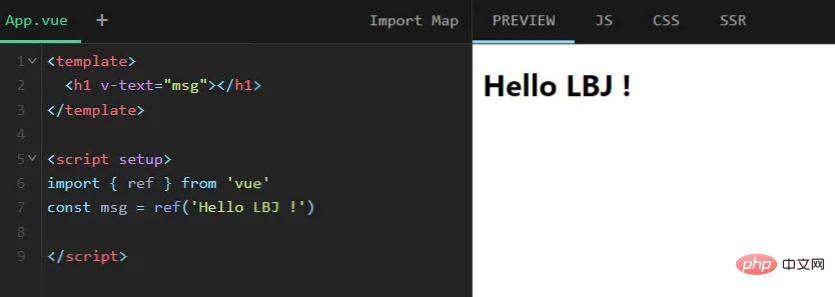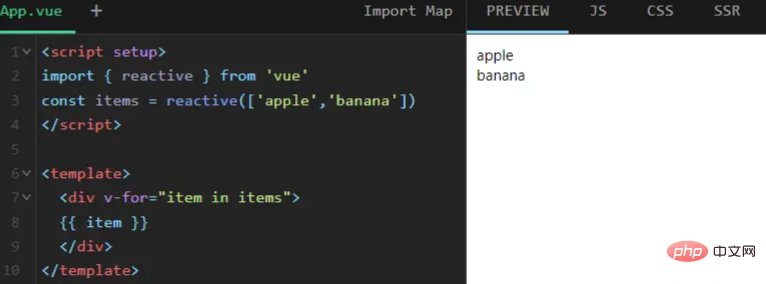
There are 16 built-in instructions: v-text, v-html, v-show, v-if, v-else, v-else-if, v-for, v-on, v-bind, v-model, v-slot, v-pre, v-cloak, v-once, v-memo, v-is; v-memo is new in 3.2, and v-is is abandoned in 3.1.0. v-show is used to control the display and hiding of elements, and v-if is used to conditionally render elements based on the true or false value of an expression.

The operating environment of this tutorial: windows7 system, vue3 version, DELL G3 computer.
In Vue, a command is actually a special attribute.
Vue will do something behind the scenes based on the command. , as for what to do specifically, Vue will perform different operations according to different instructions. The specific
## instructions will be mentioned later. What are the characteristics
An obvious feature of Vue instructions is that they all start with v-, for example: v-text<span v-text="msg"></span>
2.1 What are the built-in instructions in Vue?
The built-in instructions refer to the instructions that come with Vue and can be used out of the boxVue has a total of 16 built-in instructions, including: v-text, v-html, v-show, v-if, v-else, v-else-if, v-for, v -on, v-bind, v-model, v-slot, v-pre, v-cloak, v-once, v-memo, v-is, v-memo is new in 3.2, v-is is in 3.1 Obsolete in .0Let’s learn about the basic use of these built-in instructions2.2 Understand the basic use of the 16 built-in instructions
2.2.1 v-text
The role of v-text is to update the textContent of the element, for example:<h1 v-text="msg"></h1>

is very similar to v-text, except that v-html uses For updating the innerHTML of the element, for example
<div v-html="'<h1>Hello LBJ</h1>'"></div>
 It should be noted that the content inside must be inserted as ordinary HTML
It should be noted that the content inside must be inserted as ordinary HTML
v-show can switch the display value of the element according to the true or false value of the expression, which is used to control the display and hiding of the element, for example:
 You can see that when the conditions change, this command triggers the transition effect of showing or hiding.
You can see that when the conditions change, this command triggers the transition effect of showing or hiding.
Note: v-show does not support the element, nor does it support v-else
2.2.4 v-ifv-if is used to conditionally render elements based on the true or false value of an expression
Compared with v-show Than, v-if is the destruction or reconstruction of the element when switching, rather than simply showing and hiding
 You can see that when the expression is false, v-if is Destroy the element directly, while v-show only hides it visually
You can see that when the expression is false, v-if is Destroy the element directly, while v-show only hides it visually
And v-if can be , if the element is , its content will be extracted as a conditional block
2.2.5 v-elsev-else does not require an expression, which means adding an "else block", which is equivalent to displaying the elements of v-if when v-if meets the conditions , otherwise display v-else elements, for example:
 Note: the sibling element before v-else must have v-if or v-else-if
Note: the sibling element before v-else must have v-if or v-else-if
Similarly, it represents the "else if block" of v-if. Like v-else, the previous sibling element must have v -if or v-else-if, for example:

v-for one for Iterative instructions can render elements or template blocks multiple times based on source data, for example:
 You can also specify aliases for array indexes or keys for objects
You can also specify aliases for array indexes or keys for objects
<div v-for="(item, index) in items"></div> <div v-for="(value, key) in object"></div> <div v-for="(value, name, index) in object"></div>
v-on is used to bind events to elements, which can be abbreviated as: @
Modifier
.passive - { passive: true } 模式添加侦听器
例如:
<!-- 停止冒泡 --> <button @click.stop="doThis"></button>
需要注意,用在普通元素上时,只能监听原生 DOM 事件。用在自定义元素组件上时,也可以监听子组件触发的自定义事件
2.2.9 v-bind
v-bind用于绑定数据和元素属性,可以缩写为: 或.(当使用 .prop 修饰符时),比如
<div :someProperty.prop="someObject"></div> <!-- 相当于 --> <div .someProperty="someObject"></div>
v-bind的3个修饰符
.camel - 将 kebab-case attribute 名转换为 camelCase
.prop - 将一个绑定强制设置为一个 DOM property。3.2+
.attr - 将一个绑定强制设置为一个 DOM attribute。3.2+
2.2.10 v-model
v-model限制于: